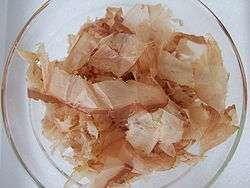Dashi
|
Katsuobushi shavings before being soaked in water | |
| Type | Soup or stock |
|---|---|
| Place of origin | Japan |
|
| |
Dashi (出汁, だし) is a class of soup and cooking stock used in Japanese cuisine. Dashi forms the base for miso soup, clear broth, noodle broth, and many kinds of simmering liquid. It is also mixed into flour base of some grilled foods like okonomiyaki and takoyaki.
Methods
The most common form of dashi is a simple broth or fish stock made by heating water containing kombu (edible kelp) and kezurikatsuo (shavings of katsuobushi - preserved, fermented skipjack tuna) to near-boiling, then straining the resultant liquid. The element of umami, considered one of the five basic tastes in Japan, is introduced into dashi from the use of katsuobushi. Katsuobushi is especially high in sodium inosinate, which is identified as one source of umami.[1]
Homemade dashi, made from dried kombu and katsuobushi, is less popular today, even in Japan.[2] Granulated or liquid instant dashi replaced the homemade product in the second half of the 20th century. Compared to the delicate nuanced taste of homemade dashi, instant dashi tends to have a stronger, less subtle flavor, due to the use of chemical flavor enhancers—glutamates and ribonucleotides.[3]
Variations
Other kinds of dashi stock are made by soaking kelp, niboshi, or shiitake in water for many hours or by heating them in near-boiling water and straining the resulting broth.
- Kombu dashi stock is made by soaking kelp in water.
- Niboshi dashi stock is made by pinching off the heads and entrails of small dried sardines, to prevent bitterness, and soaking the rest in water.
- Shiitake dashi stock is made by soaking dried shiitake mushrooms in water.
History
In 1908, the unusual and strong flavor of kelp dashi was identified by Kikunae Ikeda as umami, the "fifth flavor", attributed to human taste receptors responding to glutamic acid.[4]
See also
References
- ↑ Hosking, Richard (2000). At the Japanese Table. Images of Asia. New York: Oxford University Press. p. 43. ISBN 978-0-195-90980-7. LCCN 00058458. OCLC 44579064.
- ↑ Ingredients used for making dashi at home cooking (Japanese).
- ↑ Ozeki, Erino (2008). "Fermented soybean products and Japanese standard taste". In Christine M., Du Bois. The world of soy. Food series. Urbana: University of Illinois Press. p. 155. ISBN 978-0-252-03341-4. LCCN 2007046950. OCLC 177019229.
- ↑ Lindemann, B. (2002). "The Discovery of Umami". Chemical Senses. 27 (9): 843–844. doi:10.1093/chemse/27.9.843. ISSN 1464-3553. PMID 12438211.
Additional reading
- Hosking, Richard (1995). A Dictionary of Japanese Food. Tuttle. ISBN 0-8048-2042-2.
| Wikibooks Cookbook has a recipe/module on |
| Wikibooks has a book on the topic of: Cookbook:Dashi |
| Wikimedia Commons has media related to Dashi. |
